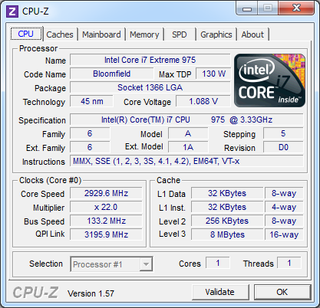Tom's CPU Architecture Shootout: 16 CPUs, One Core Each, And 3 GHz
The CPU landscape is really complex. Both AMD and Intel offer tons of different models. But how would today’s processors perform if they didn't have multiple cores? We take 16 different CPUs and compare them all using a single core running at 3 GHz.
Modern Quad-Core CPUs: AMD Deneb And Intel Sandy Bridge
AMD Deneb, 45 nm (Phenom II X4 980, Rev. C3)

AMD's quad-core Deneb design shares its basic architecture (like the Socket AM3 interface, dual-channel DDR3-1333 controller, and 45 nm manufacturing process) with the six-core Thuban configuration. Because it includes fewer cores, most models enjoy a lower 95 W TDP. However, the Phenom II X4 980's lofty 3.7 GHz default clock rate pushes it up to 125 W.
Intel Sandy Bridge, 32 nm (Core i5-2500K, Core i7-2600K, Rev. D2)

We decided to test two Sandy Bridge-based quad-core processors for the LGA 1155 interface. The Core i7-2600K has 8 MB of shared L3 cache, while the Core i5-2500K does its job with 6 MB of shared L3 cache. They all have 256 KB of L2 cache per core.
Compared to the 32 nm hexa-core Gulftown design, Sandy Bridge appears very similar. However, it represents the second generation of Intel's Core architecture, as many aspects of it were redesigned. It employs an internal ring bus to shuttle data around faster, and it adds support for the company's AVX extensions (not to mention the built-in HD Graphics engine and Quick Sync functionality).
This architecture is expected to be the basis for all upcoming desktop, server, and notebook processors in 2011, and they'll continue existing once Ivy Bridge-based chips start to emerge. As you will see in the benchmarks, Sandy Bridge delivers the best performance per clock.

Intel Lynnfield, 45 nm (Core i7-875K, Rev. B1)
Stay on the Cutting Edge
Join the experts who read Tom's Hardware for the inside track on enthusiast PC tech news — and have for over 25 years. We'll send breaking news and in-depth reviews of CPUs, GPUs, AI, maker hardware and more straight to your inbox.

The 45 nm Lynnfield design is available commercially as Intel’s first-gen Core i7 and Core i5 for the LGA 1156 interface.
It's important to pay attention to the model numbers, as Intel's Core i7-900-series requires an LGA 1366 interface, while the Core i7-800-series is designed to drop into the LGA 1156 interface. Confusing the two would naturally create an interoperability issue.
Lynnfield has 8 MB of L3 cache and 256 KB of L2 cache per core, a 95 W TDP, and an integrated DDR3 controller that supports two channels of 1333 MT/s memory.
Intel Bloomfield, 45 nm (Core i7-975, Rev. D0)

This was the first Nehalem-based quad-core processor designed for high-end desktops and workstations. Despite their age, Core i7 chips centering on the Bloomfield layout are still very modern. But they lack some of the company's newer features like AES-NI and AVX.
Current page: Modern Quad-Core CPUs: AMD Deneb And Intel Sandy Bridge
Prev Page Six-Core CPUs: AMD Thuban And Intel Gulftown Next Page Modern Dual-Core CPUs: AMD Regor And Intel ClarkdaleMost Popular

